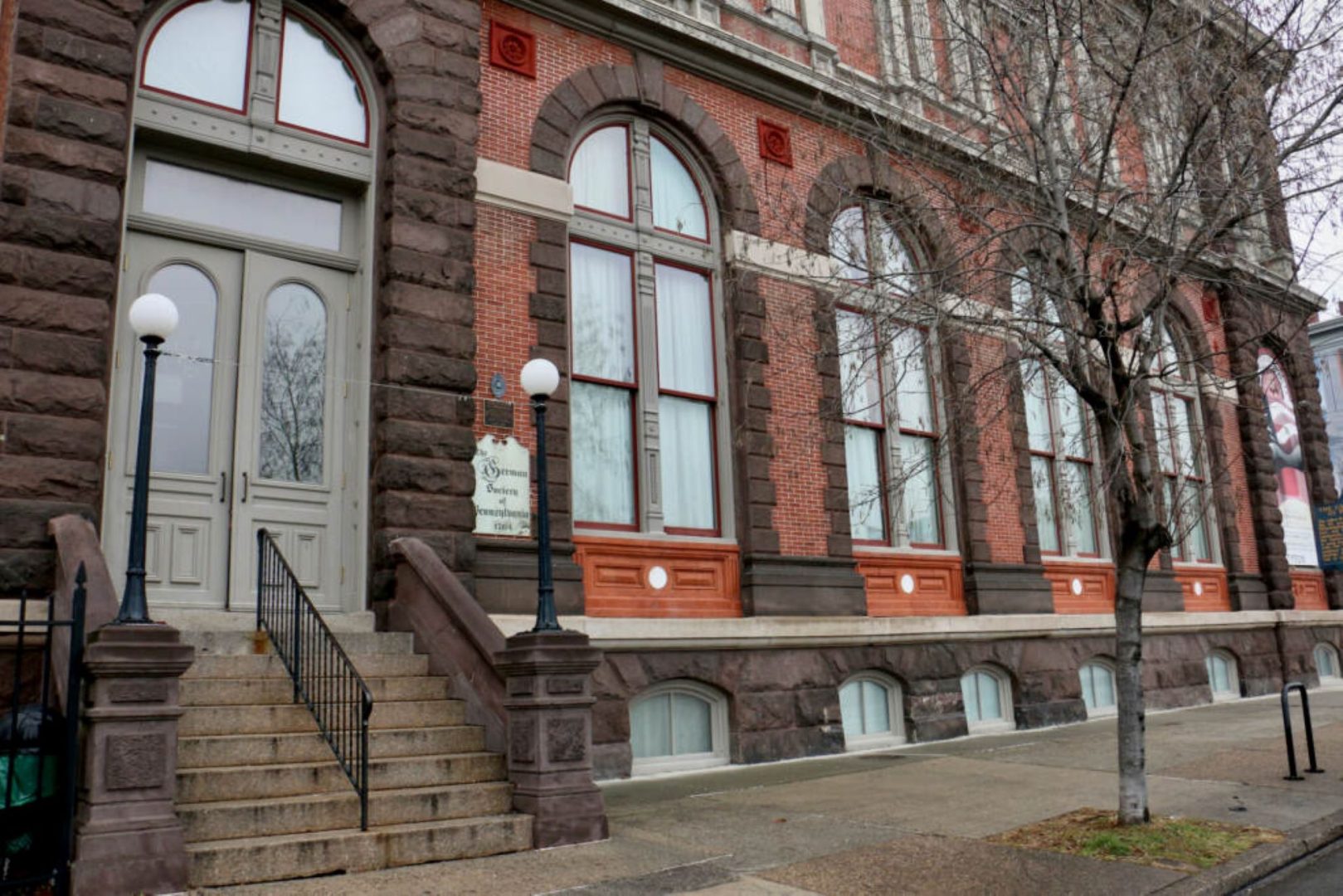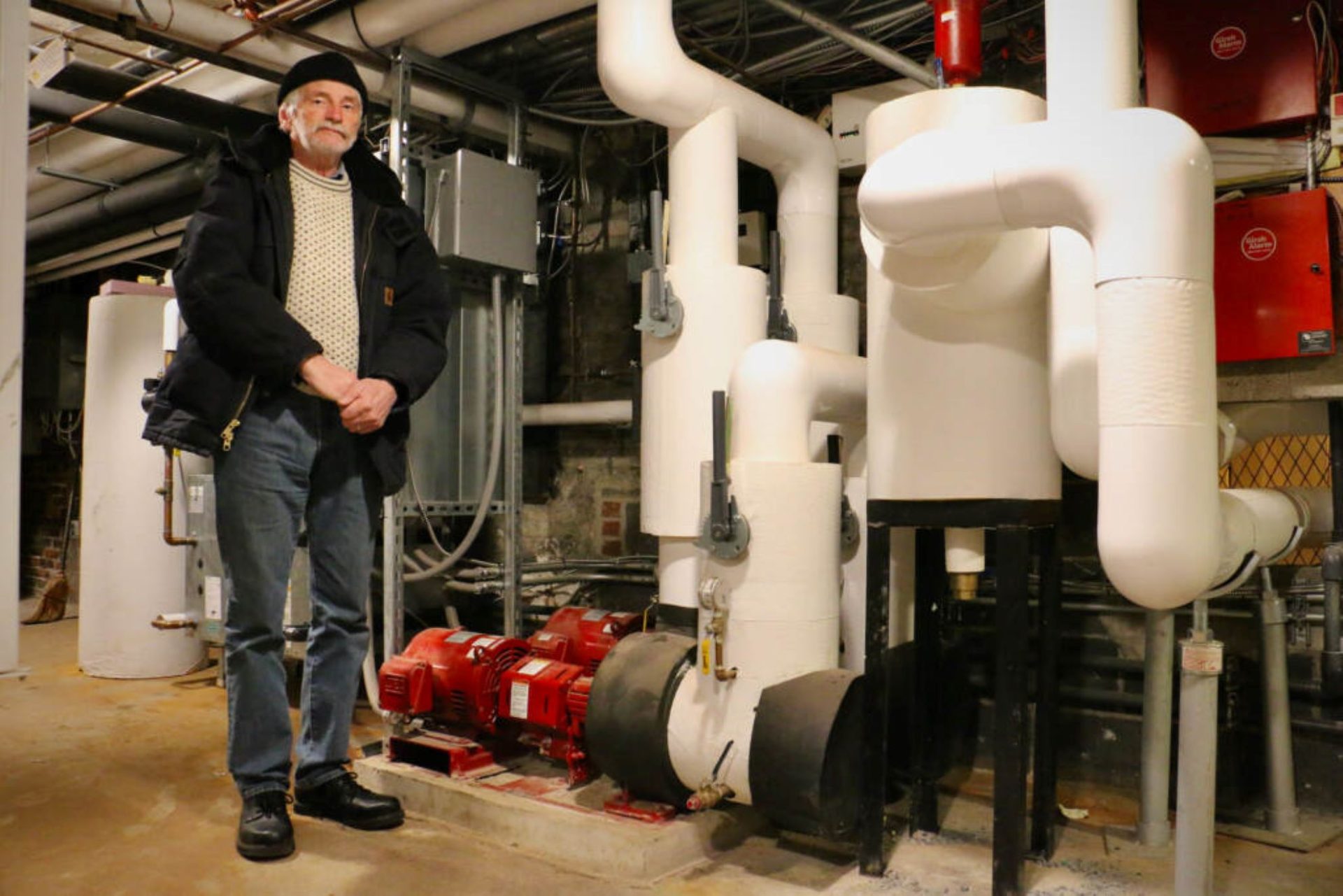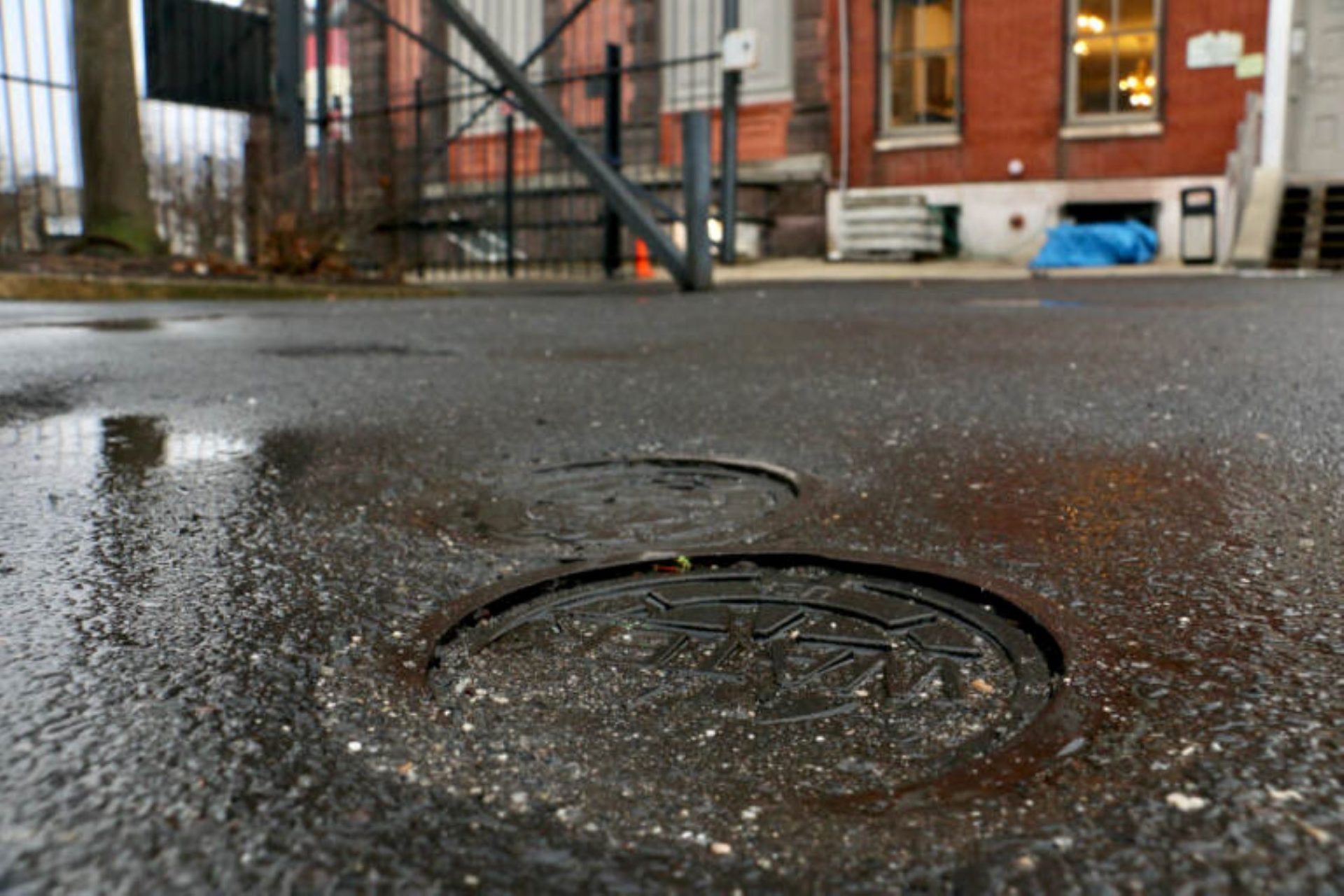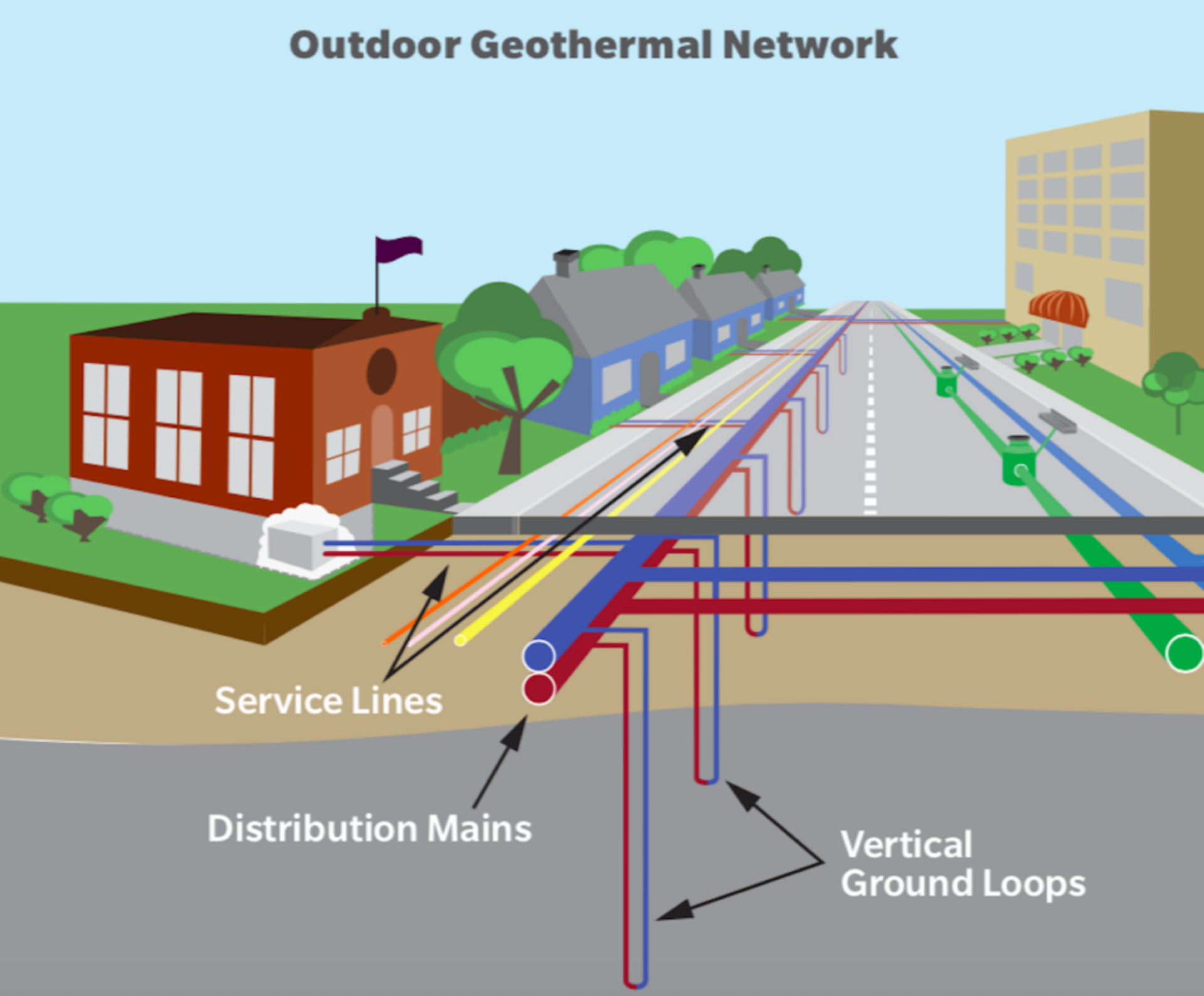
The Philadelphia skyline.
Emma Lee / WHYY


The Philadelphia skyline.
Emma Lee / WHYY

Emma Lee / WHYY
The Philadelphia skyline.
Think geothermal energy, and Iceland might come to mind. All the heat from the island’s hot thermal springs runs through underground pipes to heat homes and keep the pavements free of ice and snow. But there’s also another type of geothermal energy that could be tapped for heating and cooling, and it sits right beneath our feet here in the United States.
Dozens of large buildings and homes throughout the region use geothermal, including the Ronald McDonald House in West Philadelphia, the city’s police academy, New Jersey’s Stockton State College, and the German Society of Pennsylvania, a 20,000 square foot three-story Victorian townhouse built in 1829 that sits near the corner of Sixth and Spring Garden streets in Philadelphia.
“We had a steam heating system for parts of the building,” said Tony Michels, the society’s former president, who spearheaded the shift to geothermal six years ago. “We had a hot water system, we had split units, window units, you name it, we had fireplaces. We had everything you can imagine, and we eliminated all of that.”
They got rid of it because it was expensive, inefficient, and added climate-warming pollution to the atmosphere. They switched to geothermal energy to both heat and cool the building, which includes an addition built in 1888 and houses a library, a ballroom and concert hall, and a bar in the basement.
“For us, it was the perfect solution,” Michels said.

Emma Lee / WHYY
Tony Michels, an engineer and former president of the German Society of Pennsylvania, helped design the geothermal system that heats and cools the historic building.
Michels, along with a lot of environmentalists, geothermal advocates, and some local officials, want to see the city-owned gas utility, Philadelphia Gas Works, switch away from fossil fuels. And to them, geothermal is the perfect solution.
Audrey Schulman is executive director of the Cambridge, Massachusetts-based organization HEET.
“It’s crazy that we bring explosive gas into our homes and light it on fire to make grilled cheese sandwiches,” she said. “So if I’m given a choice of something that’s safer, results in better indoor air quality, gives me cooling, which we will need more and more, and will cost the same or less, I think it’s clear what I would want.”
Schulman has worked with investor-owned gas utilities in Massachusetts to launch geothermal pilot projects. She said a company like PGW not only contributes to global warming through leaking pipes that emit methane, but that those leaking pipes are also dangerous and expensive to replace.
“PGW is assuming that up until 2057, it will continue to install fossil fuel infrastructure that will not be paid off for 50 years after that,” she said. “That means our children and grandchildren are going to be paying for fossil fuel infrastructure that, in all likelihood, they will not need. Instead, let’s direct that money toward something we can use in the future.”
The most expensive part of a geothermal installation is the drill rig. Holes need to go deep enough in the ground to reach the bedrock.
In the case of the German Society of Pennsylvania, that’s about 400 feet through the Wissahickon schist, to eventually hit granite. The temperature in that part of the earth is a consistent 55 degrees — think of it like a 55-degree storage facility. Holes in vertical loops are lined with high-density polyethylene pipes and filled with water.
The German Society’s parking lot served as the well field for the ground loop system. It was dug up and the pipes installed, and today, there’s nothing to see but half a dozen metal plates that read “water” marking the boreholes. And nothing to hear but nearby traffic.
“There are two circulation pumps that are circulating the water through all these loops up, down, up, down, up, 23 times,” said Michels.
The water flowing through those vertical looped pipes will be in the ground long enough to reach that steady temperature of about 55 degrees. Michels’ friend Jack DiEnna has worked with geothermal for decades, including when he worked at PECO. He’s now the executive director of the Geothermal National and International Initiative. DiEnna refers to it as caveman technology.
“Because if you walk into a cave right now, it’s ground temperature,” he said. “It could be 15 degrees outside. It’s going to be 55 degrees in the cave. It’s the same concept.”
From beneath the parking lot, that 55-degree water then flows into the basement to a heat pump located in the society’s former vault. The water is used to heat the building in winter — or cool it in the summer.
“What people don’t realize is they’ve lived with the heat pump their whole life,” said DiEnna. “It’s called a refrigerator. It’s the same thing.”

Emma Lee / WHYY
Metal caps marked ”WATER” are the only evidence of the 500-foot wells beneath the parking lot of the German Society of Pennsylvania on Spring Garden Street. The wells tap the geothermal energy of the earth to heat and cool the society’s building.
Check out the back of your refrigerator — it’s hot. That’s because it’s removing the heat from the inside and dumping it into your kitchen. In the winter, your refrigerator doesn’t have to work very hard. When it’s summertime and 90 degrees, your refrigerator works really, really hard.
But a heat pump operating with 55-degree water running through it no matter the season doesn’t have to work hard in summer or winter. That’s a very happy heat pump that uses very little electricity. And there’s no need for carbon-polluting natural gas to heat the home. The heat pump also does something natural gas can’t, it provides air conditioning as well.
Michels said the whole thing cost about $1.4 million at the German Society — but they were going to spend that much anyway to put in a new heating and cooling system to preserve their rare book collection. And their gas bill went down from $1,200 a month to just $63 a month.
Philadelphia wants to see if this can work on a larger scale, and possibly replace natural gas. Philadelphia Gas Works has agreed to take steps toward exploring how to reduce its carbon footprint as part of the city’s overall goal of reaching net zero carbon emissions by 2050. The 81-page PGW Business Diversification Study, released in December, aims to tackle the difficult question of how the city can meet its climate goals while also owning a fossil fuel company that provides heating and cooking gas to about 500,000 city residents, almost one-quarter of whom live below the federal poverty level. Philadelphians spend on average 6.7% of their incomes on energy, double the national average.
The diversification report recommends further study into three separate future pathways for PGW: expanded weatherization; harvesting sewer gas or landfill gas that produces methane; and networked geothermal.
Cary Smith worked for decades in the oil and gas industry before shifting to geothermal in the 1990s and is now part of the GreyEdge Group, a consulting firm that includes some of the world’s leading experts in the field. Smith designed one of the first district geothermal systems for Colorado Mesa University.
“It’s a practical application and modification of the technology to do what we need to do with it,” he said. “And we’re finding out that this is a lot more versatile than we thought it was.”
Instead of just one building like the German Historical Society striking out on its own, with district or networked geothermal (some call it a GeoGrid), a utility like PGW would drill down into a playground, a field, or even an intersection, lay the pipe, add the water, and install heat pumps in all the neighboring homes. That system would be used to heat and cool an entire neighborhood.
Smith said the costs are going down because the piping now used lasts 50 years and the loop systems use less of it. He said costs of installation need to be weighed against the heavy costs associated with climate change, and with replacing PGW’s aging pipe system.
“Then, all of a sudden, different cost structures emerge,” he said. “And those different cost structures emerging are dictating the change. It’s still economically driven, as much as we like to think that we’re becoming more moral.”
Smith said he’s amazed by how much potential exists in district geothermal. “Back in the ’60s, we all decided we were going to do something to change the world. And you know, I got a chance to do that, and I don’t think everybody had that opportunity.”
It’s not clear how eager PGW is to wean itself off gas. Company executives participated in the diversification study with the city. But along with other gas industry utilities, they’ve also opposed electrification. PGW’s new CEO, Seth Shapiro, would not agree to an interview for this story.
Eversource, a gas and electric utility that serves 4 million customers in New Hampshire, Connecticut, and Massachusetts, will soon be testing networked geothermal in Framingham, a suburb of Boston.
Nikki Bruno, director of clean technologies at Eversource, said there was no trouble signing people up despite the headaches of digging up the street. The residents wanted clean energy, and they will get the added advantage of air conditioning as well as heating.
“I think some people are probably asking, ‘Why is the gas company doing this, because it’s a form of electrification,’” Bruno said. “I think the bottom line is a lot of the piping, it’s long-lived, over 50 years of asset life. We have that skill set in laying gas pipes. It’s actually the same type of pipe we use for our gas distribution. We see this as a great decarbonization opportunity, but we certainly need to learn more, especially about costs.”
The pilot program’s budget is about $10 million to build the well field beneath a street that will serve 100 residential and commercial customers. It will also cover the costs of new equipment like heat pumps or duct work for customers. Eversource plans to charge a flat fee at first, but may move toward metering charges. While customers’ gas or oil bills will be eliminated, their electricity use will increase due to the need to power the heat pump.
Bruno said finding the right community was key.
“Finding a community that wants to work with you, that wants to help us, because it’s digging up roads and installing vertical loops and disrupting customer homes,” she said.
Philadelphia wants to be carbon neutral by 2050. But that’s tricky when you own a fossil fuel utility that serves a largely impoverished population and employs about 1,100 people in good-paying union jobs. Nobody wants to lose a job.
PGW’s union, Gas Works Employees Union Local 686, would not agree to an interview for this story. But its president, Keith Holmes, in a recent op-ed in The Philadelphia Inquirer, said geothermal would result in the loss of union jobs and higher energy costs.
“Too often in these debates, there’s two sides that are very far apart and it becomes very rancorous,” said City Controller Rebecca Rhynhart, who sits on the Philadelphia Gas Commission, which approves PGW’s budget.
“One thing I want to be mindful of is we need to be looking at it from the perspective of how do we tackle the goals of reducing carbon emissions at the same time that we represent the working families that work for the utility and also the customers that we serve?” Rhynhart said. “And so, it is a complicated issue.”
Though there’s an urgent need to get off fossil fuels, she said, any type of transition needs to take into account PGW’s unionized workforce and its impoverished customers.
“And so what we need to do is find ways to actually develop that trust between the parties and move forward,” Rhynhart said.
City Councilmember Derek Green, who chairs the Gas Commission, said he’s hopeful PGW can find a way to transition toward renewable energy and get the union workforce on board with new jobs. He said he’s had conversations with the United Steelworkers, a union that he noted does feel optimistic about jobs in geothermal. After all, because of climate change, heating with gas is going the way lighting with gas did.
“PGW started in 1836 as a lighting company, and then it transitioned to a heating company using gas to provide heat for the home,” he said. “So we’re now going on a precipice of another transition. Those conversations need to start now, because you can’t take an entity that’s been around since 1836,and switch overnight.”
Green said he wants to use federal infrastructure dollars to pay for geothermal infrastructure. He’s holding hearings this week in City Council to discuss options for PGW to decarbonize, including networked geothermal.

Eversource
A diagram of district geothermal, where the vertical pipes deliver water at a consistent temperature to ground source heat pumps inside homes and commercial buildings.
The city’s director of sustainability, Christine Knapp, said she’s also optimistic the union will see opportunities rather than just a loss of jobs due to electrification. The PGW diversification study included an analysis of the impacts of decarbonization on the workforce. But Knapp said she has lined up funding to do a more thorough analysis in conjunction with Local 686.
“And that will really take a look at preexisting workforce demographics, retirement age, pension obligations, and obviously job titles and skill sets,” she said. “We need a better understanding of what the impact would be on their workforce, but also on potential new workforce job creation.”
Since Pennsylvania utility regulations prohibit ratepayers from paying for the pilot program, Knapp said she has also been seeking outside funding for a networked geothermal demonstration project.
Jack DiEnna, of the Geothermal National and International Initiative, said the union workers have nothing to worry about because there would be plenty of jobs in networked geothermal nationwide.
“Our industry is 90% blue-collar or hands-on tradesmen,” he said. “If we got 30% of the HVAC market, we would have to create and retain 5 million jobs. So that’s 5 million jobs in which 90% of those are going to be tradesmen.”
DiEnna said that would include everyone from those operating the drill rigs, to those installing and maintaining pipes and new HVAC systems.
Tony Michels, of the German Society of Pennsylvania, said it’s time to seize the moment.
“It would make sense for PGW to open up their eyes and say, ‘We should be serious and honest about it and promote this technology in places where we can make a profit,’” Michels said. “Now is the time when there is public money available for this. If they don’t change, they will be changed.”
StateImpact Pennsylvania is a collaboration among WITF, WHYY, and the Allegheny Front. Reporters Reid Frazier, Rachel McDevitt and Susan Phillips cover the commonwealth’s energy economy. Read their reports on this site, and hear them on public radio stations across Pennsylvania.
(listed by story count)
StateImpact Pennsylvania is a collaboration among WITF, WHYY, and the Allegheny Front. Reporters Reid Frazier, Rachel McDevitt and Susan Phillips cover the commonwealth’s energy economy. Read their reports on this site, and hear them on public radio stations across Pennsylvania.
Climate Solutions, a collaboration of news organizations, educational institutions and a theater company, uses engagement, education and storytelling to help central Pennsylvanians toward climate change literacy, resilience and adaptation. Our work will amplify how people are finding solutions to the challenges presented by a warming world.